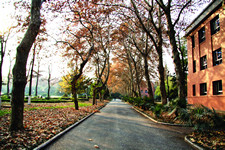
- 【CGTN】Antiferromagnetic phase transition observed in fermi...
- Chinese Scientists Create Multi-node Entanglement in Metropo...
- Two Breakthroughs from USTC Selected China’s Top 10 Scienti...
- Great Minds in Quantum Technology Sparkled in Hefei: 2023 In...
- [Xinhua News]China's Computational Power Gains New Strength ...
USTCer Finds Bigger Possibilities for Alien Life
-
 [2013-01-20]
[2013-01-20] -
15 new possible habitable planets are found and one of them is confirmed to be giant planet. Alien life is very likely existing on their moons, researchers of Planet Hunters reported on Jan 7, among whom USTC Alumnus Wang Ji made a major contribution.

Fig: Artist's impression of the view from a moon around planet PH2b. / Haven Giguere.
Researchers published their discovery of another 15 habitable planets on the 221st meeting of the American Astronomical Society, including a Jupiter-sized planet orbiting a Sun-like star that has been officially confirmed as a inhabitable planet (with 99.9% certainty) and has been given the name 'PH2 b'. It is the second confirmed planet to be found by Planethunters.org.
Added to 19 planets already discovered in habitable zones, the 15 fresh ones increased the number of known places in our galaxy theoretically hospitable to life significantly. Alien life is much more possible on these planets’ moons, where the temperature is neither too hot nor too cold for liquid water. The new finds suggest that there may be a 'traffic jam' of all kinds of strange worlds in regions that could potentially support life.
WANG Ji, the 2002th applied physicsalumni of USTC and now a postdoctor in Yale, is the primary author of ‘Planet Hunter’ Series and he said: ‘This is just the beginning of the great goal in finding a suitable place for life elsewhere. Any moon orbiting around the identified genuine planet may have life, just like the moon Pandora did in fictional movie Avatar’. The 5th part of this article has been submitted to the Astrophysical Journal.
‘Planet Hunter’ is an united project team and established by Yale, Oxford and other research institutes to call on volunteers helping professional scientists search for extrasolar planet. Volunteers’ main work are analyzing materials collected by the Kepler Space Telescope, then, hand over valuable ones to astronomer for further check. More than 200,000 participants have contributed since 2010.
(GUO Hongjun, USTC News Center)
